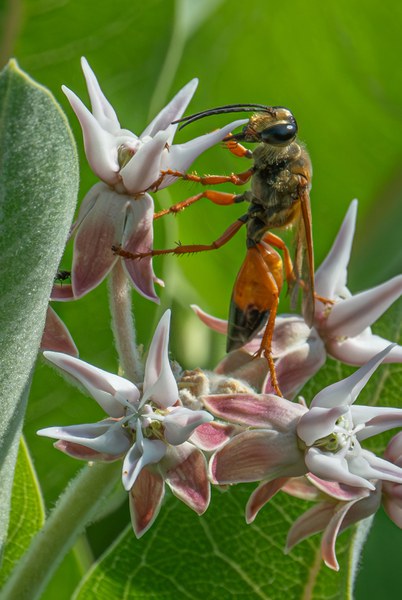There’s a beneficial bug in your garden, digging around. Often we seem to look right past them, but this summer we've seen these insects frequently, often pollinating our flowers. It’s the great golden digger wasp!
The great golden digger wasp (Sphex ichneumoneus) is a solitary ground nesting wasp. Its name comes from the Greek word for “tracker,” which is very apt, as you’ll soon discover. This wasp is most well-known for its parasitic nesting behavior.

Once back at the nest, the great golden digger wasp lays down their paralyzed prey. She enters her tunnel and checks to ensure that all is well in the side chambers. Then, the wasp brings the prey down into a side chamber, lays an egg on the prey, and seals the chamber. Once the egg hatches, it has a lovely buffet to eat through the winter. In the spring, the new wasp emerges from its side chamber and begins the cycle anew.
These are possibly the only wasps known to be attacked by birds—including house sparrows and American robins—so that they drop their prey and the birds can have a tasty snack instead.
Great golden digger wasps are beneficial to our gardens for several reasons. Their main prey—those grasshoppers and crickets—can be a pest in the garden, eating ornamental plants. The wasps also pollinate flowers, aerate the soil, and help water soak into the ground through their tunnels. In addition, these solitary wasps are non-aggressive towards humans, pets, and livestock, preferring to save their venom for their prey.
Great golden digger wasps can be 1/2 inch to more than one inch long! Golden hairs cover their head and thorax (hence the “golden” in their common name). Great golden digger wasps have a long, slender petiole (or “waist”). Their metasoma, or hind region, is black with the first couple of segments a brilliant orange-red that matches their legs.
Keep watch in your garden and in sandy areas for these delicate creatures for the next few weeks, before the cold arrives and the next generation waits to emerge in the spring.
Sources:
- Great Golden Digger Wasps: Scary Good, Missouri Department of Conservation
- Great Golden Digger Wasp: Another Asian Giant Hornet Look-Alike, University of Wisconsin Madison Insect Diagnostic Lab
- Great Golden Digger Wasp, Galveston County Master Gardeners
Learn more:


